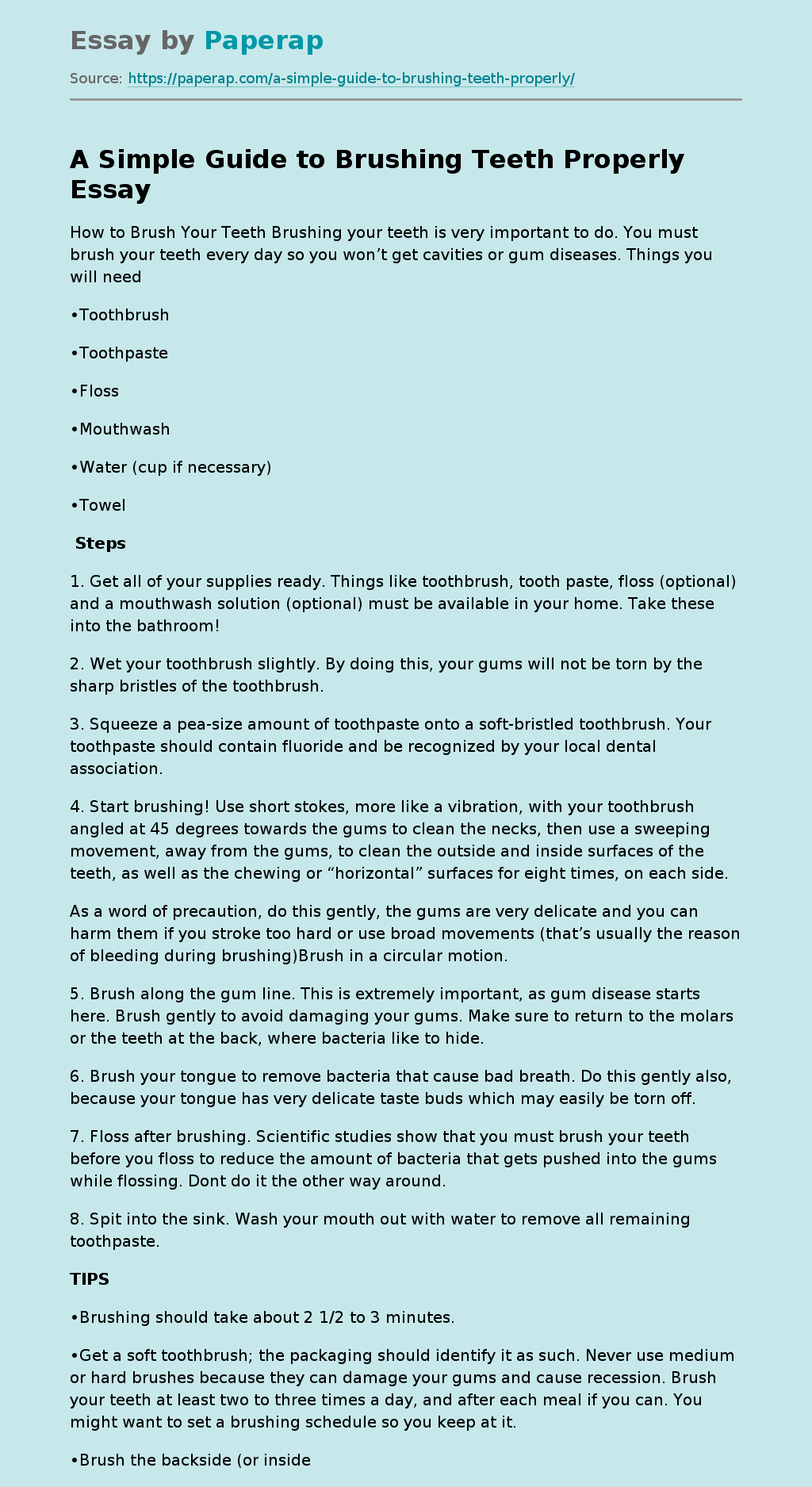How to Brush Your Teeth Brushing your teeth is very important to do. You must brush your teeth every day so you won’t get cavities or gum diseases. Things you will need
•Toothbrush
•Toothpaste
•Floss
•Mouthwash
•Water (cup if necessary)
•Towel
Steps
1. Get all of your supplies ready. Things like toothbrush, tooth paste, floss (optional) and a mouthwash solution (optional) must be available in your home. Take these into the bathroom!
2. Wet your toothbrush slightly. By doing this, your gums will not be torn by the sharp bristles of the toothbrush.
3. Squeeze a pea-size amount of toothpaste onto a soft-bristled toothbrush. Your toothpaste should contain fluoride and be recognized by your local dental association.
4. Start brushing! Use short stokes, more like a vibration, with your toothbrush angled at 45 degrees towards the gums to clean the necks, then use a sweeping movement, away from the gums, to clean the outside and inside surfaces of the teeth, as well as the chewing or “horizontal” surfaces for eight times, on each side.
As a word of precaution, do this gently, the gums are very delicate and you can harm them if you stroke too hard or use broad movements (that’s usually the reason of bleeding during brushing)Brush in a circular motion.
5. Brush along the gum line. This is extremely important, as gum disease starts here. Brush gently to avoid damaging your gums. Make sure to return to the molars or the teeth at the back, where bacteria like to hide.
6. Brush your tongue to remove bacteria that cause bad breath.
Do this gently also, because your tongue has very delicate taste buds which may easily be torn off.
7. Floss after brushing. Scientific studies show that you must brush your teeth before you floss to reduce the amount of bacteria that gets pushed into the gums while flossing. Dont do it the other way around.
8. Spit into the sink. Wash your mouth out with water to remove all remaining toothpaste.
TIPS
•Brushing should take about 2 1/2 to 3 minutes.
•Get a soft toothbrush; the packaging should identify it as such. Never use medium or hard brushes because they can damage your gums and cause recession. Brush your teeth at least two to three times a day, and after each meal if you can. You might want to set a brushing schedule so you keep at it.
•Brush the backside (or inside) surfaces of your teeth – both upper and lower. Take your time and be gentle when doing this. It requires angling the tooth brush to get these surfaces. For the lower front teeth, angle the brush so the bristles are slightly below the gum line and gently pull up and out so the brush lifts any plaque and debris from around your lower gum line and teeth.
Repeat this approximately five to seven times for each area of the front teeth.
•When your toothbrush bristles fray out or become too soft, usually after 3 months, it is time to get a new toothbrush. (You can find toothbrushes that change color when the brush is ready to be thrown out. )
•If your gums start bleeding, it means they are out of shape. Make sure you are brushing properly!
•Visit a dentist at least twice a year for an exam and x-rays, and a cleaning.
•Consider using mouthwash after you brush for a fresh, clean feeling and added protection against gingivitis, etc. Floss daily. Warnings
•Never use someone else’s toothbrush. You can transfer germs, bacteria, and diseases through microscopic cuts in your mouth. •Do not go two or more days without brushing your teeth. If you do, your mouth can become very nasty and you increase your risk of periodontal disease and cavities.
•Never use the toothbrush that is used for your daily brushing for other cleaning purposes, like cleaning the tiles of the bathroom or cleaning your ears. Replace your tooth brush after every illness you suffer, as bacteria may live in the moist interior of the bristles and reinfect you.
•If you eat dessert, wait about 10 minutes before brushing. If you brush right after you eat, then you’re just spreading that sugar around more.
•You will need to make another way to Brush Your Teeth With Braces On. If you do it normally, there might be problems.
•DO NOT swallow large amounts of Toothpaste or Mouthwash. If this happens call the Poison Control Center immediately
A Simple Guide to Brushing Teeth Properly. (2019, Dec 05). Retrieved from https://paperap.com/a-simple-guide-to-brushing-teeth-properly/

